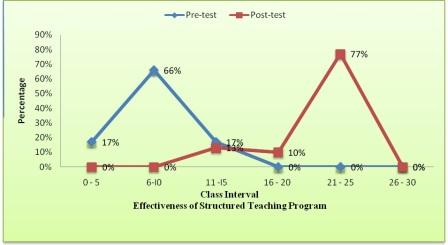A study to assess the effectiveness of the structured teaching program on prevention of pressure ulcer by using Braden scale among staff nurses working in selected hospital of Bhopal
Abstract
Introduction: Pressure ulcers are common in a variety of patient setting and are associated with adverse health outcomes and high treatment costs. The Braden scale is a widely used pressure risk assessment tool with highly satisfactory reliability 0.99 when used by registered nurses. Present study focused on assessment of the knowledge level of staff nurses on prevention of pressure ulcer by using Braden scale.
Methods: The sample for the present study comprised of 30 staff nurses who met the inclusive criteria. Assessed pre-test knowledge level with structured questionnaire, all the respondents had poor practice of pressure ulcer risk assessment and its prevention. Administered structured teaching program and post assessment was done.
Results: The obtained ‘t’ value is 22.06 showing the effectiveness of structured teaching program at 0.05 level and 0.01 levels of significance.
Conclusion: There was significant relation found between structured teaching programs and knowledge level on prevention of pressure ulcer by using Braden scale. This type of studies can help staff nurses to update their knowledge and skills. Ultimately, it will improve the quality of services provided in the hospital.
Downloads
References
2. Maklebust J, Magnan MA. A quasi-experimental study to assess the effect of technology-assisted training on correct endorsement of pressure ulcer preventive interventions. Ostomy Wound Manage. 2009;55(2):32-42. [PubMed]
3. Magnan MA, Maklebust J. Multisite Web-based training in using the Braden Scale to predict pressure sore risk.Adv Skin Wound Care. 2008;21(3):124-133. [PubMed]
4. Magnan MA, Maklebust J. The effect of Web-based Braden Scale training on the reliability and precision of Braden Scale pressure ulcer risk assessments. J Wound Ostomy Continence Nurs. 2008;35(2):199-208. [PubMed]
5. Provo B, Piacentine L, Dean-Baar S. Practice versus knowledge when it comes to pressure ulcer prevention. J Wound Ostomy Continence Nurs. 1997;24(5):265-269. [PubMed]
6. Xakellis GC, Frantz RA, Arteaga M, Nguyen M, Lewis A. A comparison of patient risk for pressure ulcer development with nursing use of preventive interventions. J Am Geriatr Soc. 1992;40(12):1250-1254. [PubMed]
7. Braden Scale for Preventing Pressure Sore Risk. Available at: http://www.bradenscale.com/images/bradenscale.pdf. Accessed August 16, 2013.
8. Saleh M, Anthony D, Parboteeah S. The impact of pressure ulcer risk assessment on patient outcomes among hospitalised patients. J Clin Nurs. 2009 Jul;18(13):1923-1929.



 OAI - Open Archives Initiative
OAI - Open Archives Initiative


